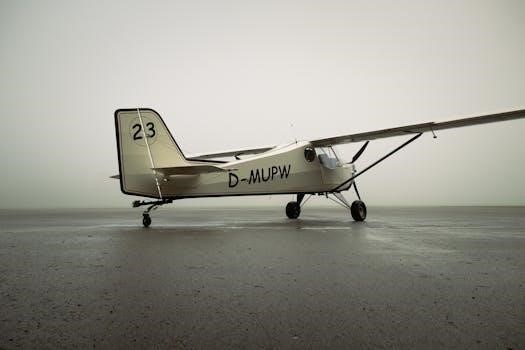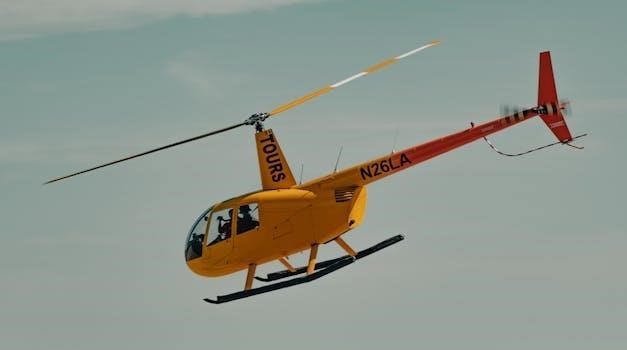
private pilot oral exam guide pdf free download
Private Pilot Oral Exam Guide⁚ Overview

The Private Pilot Oral Exam Guide serves as a vital tool for aspiring pilots. It is designed to prepare candidates for the FAA checkride. This comprehensive guide offers insights into likely questions. It provides succinct answers, and FAA references for further study.
Purpose of the Oral Exam
The primary purpose of the Private Pilot Oral Exam is to evaluate a candidate’s understanding of aviation principles. It ensures they possess the necessary knowledge to operate an aircraft safely and efficiently. Examiners assess the pilot’s grasp of regulations, aerodynamics, aircraft systems, weather, navigation, and emergency procedures. This examination isn’t merely a rote memorization test. It delves into the pilot’s ability to apply theoretical knowledge to practical scenarios.

The oral exam also gauges the pilot’s decision-making skills. It evaluates their capacity to analyze situations, make sound judgments, and mitigate risks. Examiners often present hypothetical scenarios. These scenarios require the candidate to demonstrate critical thinking and problem-solving abilities. Moreover, the oral exam serves as a platform for the examiner to assess the pilot’s communication skills. Effective communication is crucial in aviation. It ensures clear and concise information exchange between pilots, air traffic control, and other crew members. Ultimately, the oral exam aims to ensure that the pilot possesses the competence and judgment necessary for safe flight operations.
Importance of Preparation
Thorough preparation for the Private Pilot Oral Exam is paramount. It ensures a candidate’s success and demonstrates a commitment to aviation safety. Adequate preparation not only boosts confidence. It also equips pilots with the knowledge and skills to handle diverse scenarios. The oral exam evaluates a pilot’s understanding of regulations, aerodynamics, aircraft systems, weather, navigation, and emergency procedures.
Effective preparation involves studying FAA handbooks, advisory circulars, and oral exam guides. Candidates should also practice answering common questions. This practice helps solidify their understanding of key concepts. Furthermore, mock oral exams with a flight instructor can provide valuable feedback. They allow candidates to identify areas for improvement.
By investing time and effort in preparation, pilots can demonstrate their competence. It showcases their commitment to safety and professionalism. Successful completion of the oral exam is a significant milestone. It marks a pilot’s readiness to embark on their aviation journey with confidence and skill.

Key Subject Areas Covered in the Oral Exam
The oral exam assesses pilot knowledge across key areas. These encompass regulations, aerodynamics, aircraft systems, weather, navigation, and emergency procedures. Mastering these subjects is crucial for safe and proficient flight operations.
Regulations (FAR/AIM)
A thorough understanding of the Federal Aviation Regulations (FAR) and the Aeronautical Information Manual (AIM) is paramount for every private pilot. This section of the oral exam evaluates your knowledge of the rules, procedures, and operational requirements that govern aviation in the United States. You will be expected to demonstrate familiarity with regulations pertaining to airworthiness, pilot certification, aircraft maintenance, and flight operations.
Expect questions on topics such as preflight actions, right-of-way rules, airspace classifications, and weather minimums. Examiners will also probe your understanding of aircraft equipment requirements, medical certification standards, and the legal ramifications of violating aviation regulations. The ability to interpret and apply FAR/AIM guidance is essential for safe and legal flight operations. It showcases your commitment to upholding the highest standards of airmanship.
Furthermore, demonstrate your ability to locate information within the FAR/AIM quickly and efficiently. This proves your proficiency in utilizing these critical resources for informed decision-making. Remember, a solid grasp of regulations is not just about memorization; it is about understanding the rationale behind them and applying them effectively in real-world scenarios.
Aerodynamics and Principles of Flight
Understanding the forces that act upon an aircraft is crucial for any pilot. This section delves into the core principles of aerodynamics and how they relate to flight. Expect questions about lift, weight, thrust, and drag, and how these forces interact to enable flight. You should be able to explain the Bernoulli’s principle and its role in generating lift over the wing. Additionally, be prepared to discuss the factors affecting lift and drag, such as angle of attack, airspeed, and wing design.
The examiner will likely assess your understanding of stall characteristics, including the causes of stalls and the appropriate recovery procedures. You should also be familiar with the concepts of stability and control, and how control surfaces like ailerons, elevators, and rudders affect the aircraft’s attitude and direction. Furthermore, demonstrate your knowledge of ground effect and its impact on aircraft performance during takeoff and landing.
A solid grasp of these principles will not only help you pass the oral exam but also contribute to your overall safety and proficiency as a pilot. Understanding how your aircraft behaves in different flight conditions is essential for making sound decisions and maintaining control throughout your flight.
Aircraft Systems and Performance
This segment of the oral exam focuses on your knowledge of the aircraft’s various systems and their operation. Expect questions about the engine, fuel system, electrical system, and hydraulic system, if applicable to your training aircraft. You should be able to describe the purpose and function of each component within these systems. You will need to know typical operating parameters.
The examiner will also assess your understanding of aircraft performance characteristics. This includes takeoff and landing distances, climb rates, and cruise speeds. Be prepared to discuss the factors affecting performance, such as altitude, temperature, and weight. You should also be able to interpret performance charts and graphs from the Pilot Operating Handbook (POH). Understanding the limitations of your aircraft and operating within those limits is paramount to safe flight operations.
Furthermore, be ready to explain the procedures for handling system malfunctions or failures. This includes knowing the appropriate emergency checklists and how to troubleshoot common problems. A thorough knowledge of your aircraft’s systems and performance capabilities is crucial for making informed decisions and ensuring a safe and successful flight.
Weather Theory and Aviation Weather Services
This section delves into your understanding of weather phenomena and how they impact flight. The examiner will probe your knowledge of atmospheric pressure, temperature, humidity, and wind. They will also assess your ability to interpret weather charts, forecasts, and reports. You should be familiar with METARs, TAFs, and weather briefings.
Expect questions about various weather hazards, such as thunderstorms, icing, turbulence, and fog. You need to explain how these hazards form, how to identify them, and how to avoid them. Understanding the effects of weather on aircraft performance and flight planning is essential.
The oral exam will also cover aviation weather services. You need to know where to obtain weather information. This includes Flight Service Stations (FSS), Automated Weather Observing Systems (AWOS), and online resources. You should demonstrate the ability to make informed decisions based on available weather data. This will ensure safe and legal flight operations. Being able to analyze weather and make go/no-go decisions is a critical skill;
Navigation and Flight Planning
This section assesses your ability to plan and execute a flight safely and efficiently. You’ll need to demonstrate your knowledge of pilotage, dead reckoning, and electronic navigation. Expect questions about sectional charts, including how to interpret symbols, identify landmarks, and determine courses and distances. You should also be proficient in using navigation tools like plotters and flight computers.
Flight planning is a crucial aspect. You’ll be asked about factors such as weather, aircraft performance, and airport information. Examiners will want to see that you can calculate fuel requirements, estimate time en route, and determine appropriate altitudes. They’ll also explore your understanding of airspace regulations and procedures.
Understanding navigation systems like VOR, GPS, and ADF is essential. You’ll need to explain how these systems work, their limitations, and how to use them effectively. Be prepared to discuss how to deal with navigation errors and unexpected situations. Demonstrate your ability to adapt your plan while maintaining situational awareness. This ensures a safe and successful flight.
Emergency Procedures
This section evaluates your knowledge of how to respond to various in-flight emergencies. Expect questions about engine failures, fires, electrical malfunctions, and other critical situations. The examiner will assess your ability to remain calm, analyze the situation, and take appropriate action. A thorough understanding of the aircraft’s emergency procedures is essential.
You should be familiar with procedures for forced landings, including selecting a suitable landing site and preparing the aircraft for impact. Be prepared to discuss how to communicate your emergency to air traffic control and other resources. Knowledge of emergency equipment, such as fire extinguishers and first aid kits, is also important.
The examiner will likely present scenarios requiring you to make quick decisions under pressure. Demonstrate your ability to prioritize actions, follow checklists, and maintain control of the aircraft. A strong understanding of aircraft systems and their potential failure modes is crucial. This section assesses your preparedness to handle unforeseen circumstances and ensure the safety of yourself and your passengers. Effective communication is a vital part of managing emergencies.

Resources for Preparation
Effective preparation requires utilizing various resources. These resources include ASA’s Oral Exam Guide Series, FAA handbooks and advisory circulars, and online study materials. These resources provide practice questions, and a wealth of knowledge for success.
ASA’s Oral Exam Guide Series
ASA’s Oral Exam Guide Series stands as a premier resource for both students and instructors. It is designed to effectively prepare for the private pilot oral exam. Arranged in a question-and-answer format, it mirrors the practical exam. It anticipates the questions evaluators most frequently ask during the checkride process.
This comprehensive guide provides succinct, readily accessible responses. It provides clear and concise answers. FAA references are also provided throughout. These references are for those seeking deeper understanding. The series aims to instill confidence. It ensures candidates are well-prepared and knowledgeable on exam day.
The Private Pilot Oral Exam Guide, a part of this series, is regularly updated. It is kept current with the latest Airman Certification Standards. This guarantees the content remains relevant. The guide is accurate and aligned with the latest regulatory changes. Whether used for self-study or as a classroom aid, ASA’s Oral Exam Guide Series proves invaluable.
FAA Handbooks and Advisory Circulars
FAA handbooks and advisory circulars (ACs) form a cornerstone of pilot education. They are essential resources for preparing for the private pilot oral exam. These official publications offer in-depth explanations of aviation principles. They also cover regulations, procedures, and best practices.
The Pilot’s Handbook of Aeronautical Knowledge (PHAK) is a fundamental text. It covers aerodynamics, aircraft systems, weather theory, and navigation. Advisory circulars provide guidance on specific topics. These include aircraft maintenance, airport operations, and flight safety.
These resources are meticulously crafted to ensure accuracy. They also ensure currency, providing pilots with the most up-to-date information. Integrating FAA handbooks and ACs into your study routine demonstrates a commitment to thorough preparation. It also showcases a deep understanding of aviation concepts. Familiarity with these documents is crucial for success. It is an important part of the private pilot oral exam and beyond.
Online Study Materials and Practice Questions
The digital age has revolutionized pilot training. It offers a wealth of online study materials and practice questions. These resources are invaluable for preparing for the private pilot oral exam. Numerous websites and apps provide interactive study guides, videos, and quizzes.
Online practice questions simulate the exam environment. They allow you to test your knowledge and identify areas for improvement. Many platforms offer detailed explanations of the correct answers. They help you understand the underlying concepts. Online forums and communities provide a space to connect with other students. You can share insights, ask questions, and receive support.
However, it’s crucial to evaluate the credibility of online resources. Prioritize materials from reputable sources, such as the FAA and established aviation training providers. Supplement your study with official FAA publications and textbooks. This will ensure you are well-prepared for the oral exam. Use online tools as a complement, not a replacement.